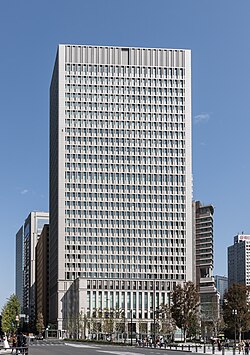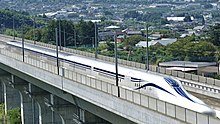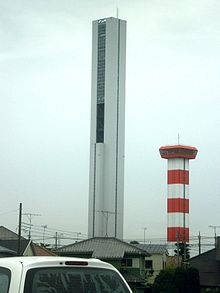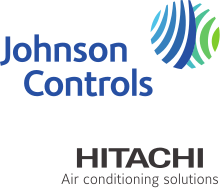Logo since 1992 | |
 Headquarters in Marunouchi, Chiyoda, Tokyo | |
Native name | 株式会社日立製作所 |
|---|---|
Romanized name | Kabushikigaisha Hitachi Seisaku-sho lit. "Share Company Hitachi Manufacturing Plant" |
| Company type | Public |
| Industry | Conglomerate |
| Founded | 1910 Hitachi, Ibaraki, Japan |
| Founder | Namihei Odaira |
| Headquarters | , Japan |
Area served | Worldwide |
Key people | Toshiaki Higashihara (Executive Chairman) Keiji Kojima(businessman) (President and CEO) |
| Products | |
| Services |
Former |
| Revenue | |
| Total assets | |
| Total equity | |
Number of employees | 268,655 (as of June 2024) |
| Website | hitachi.com |
Hitachi, Ltd.[nb 1] (Japanese pronunciation: [çi̥taꜜtɕi]) is a Japanese multinational conglomerate founded in 1910 and headquartered in Chiyoda, Tokyo. The company is active in a range of industries, including digital systems, power and renewable energy solutions, railway systems, healthcare products, and financial systems.[4] The company was founded as an electrical machinery manufacturing subsidiary of the Kuhara Mining Plant in Hitachi, Ibaraki by Namihei Odaira in 1910. It started as an independent company under its current name in 1920.[5]
Hitachi is listed on the Tokyo Stock Exchange and is a key component of the Nikkei 225 and TOPIX Core30 indices. As of June 2024, it has a market capitalisation of 16.9 trillion yen, making it the fourth largest Japanese company by market value.[6] In terms of global recognition, Hitachi was ranked 38th in the 2012 Fortune Global 500 and 129th in the 2012 Forbes Global 2000.[7] Hitachi is a highly globalised conglomerate. In the fiscal year 2023, it generated approximately 61% of its total revenue of 9.7 trillion yen from international markets. The major contributors to this global revenue were Asia, Europe, and North America, with each region accounting for 22%, 16%, and 16% of the total revenue, respectively.[8][9]
Hitachi, since its founding in 1910 by engineer Namihei Odaira, has been driven by the mission to 'contribute to society through the development of superior, original technology and products'.[10] This ethos is evident in its leadership, as all its 12 CEOs, including founder Odaira, have been from engineering backgrounds. Remarkably, 8 out of the 12 consecutive CEOs, including Odaira, are alumni of the University of Tokyo's Faculty of Engineering.[11]
Historically recognised for its technology and industrial products, including electric generators, consumer electronics, trains, computers, and nuclear reactors, Hitachi faced a pivotal moment following the 2008 global financial crisis. This crisis led to a record loss of 787.3 billion yen, prompting a strategic overhaul. The company concentrated its efforts on the 'Social Innovation Business', capitalising on its strengths in infrastructure and IT, and underwent major structural changes. These involved consolidating unprofitable operations and venturing into new fields such as digital systems and renewable energy, adapting to changing market dynamics. As a result of these strategic moves, Hitachi returned to profitability by March 2011.[12]
Today, Hitachi's corporate activities are organised into three large sections: Digital Systems and Services, Green Energy and Mobility, and Connective Industries.
The Digital Systems and Services segment features Lumada, in which Hitachi provides advanced digital solutions that leverage data and technology to drive transformation and efficiency in various industries. This segment focuses on optimising business processes and enhancing operational efficiency through data-driven insights and innovative technologies. This segment accounted for 21.9 per cent of the total revenue in FY2022.[13]
The Green Energy and Mobility segment focuses on developing and providing highly efficient and dependable power systems globally. This includes power generation, transmission, and distribution systems. Additionally, Hitachi offers smart city energy solutions, contributing to sustainable urban development. In the rail industry, the company is a comprehensive system provider, offering everything from rolling stock and traction equipment to signalling, traffic management systems, and maintenance depots. A key component of this segment is the ZeroCarbon suite of solutions, designed to enable fleet operators to transition to electric vehicles, supporting a future with net zero emissions. This segment accounted for 22.9 per cent of the total revenue in FY2022.[14][13]
In the Connective Industries segment, Hitachi offers a range of infrastructure solutions. This includes building systems such as elevators and escalators, healthcare solutions with a focus on less invasive cancer treatments and diverse medical equipment, and a variety of essential industrial equipment such as air compressors and transformers. Additionally, the segment provides sustainable water and wastewater solutions, integrating advanced treatment technologies with ICT for efficient resource management. This segment accounted for 27.3 per cent of the total revenue in FY2022.[13][15]

Founded in 1910 in Ibaraki Prefecture by electrical engineer Namihei Odaira, Hitachi's first product was Japan's inaugural 4-kilowatt induction motor, designed for copper mining.[16][17][18] Originally an in-house venture of Fusanosuke Kuhara's mining company, Hitachi became independent in 1911 and moved its headquarters to Tokyo in 1918. The company's name 'Hitachi', combining the kanji for 'sun' (日, hi) and 'rise' (立, tachi), was coined by Odaira.[19] While industrial machinery in Japan was usually powered by steam at the time, Odaira built water power stations in the mine and electrified almost all facilities in the factory. This led to the accumulation of expertise in electrical engineering, and helped the company develop various electrical equipment later in its history. In 1924, Hitachi completed Japan's first mainline electric locomotive (JNR Class ED15). In 1932, the company started manufacturing elevators and electric refrigerators.[20]
World War II and its aftermath significantly impacted Hitachi, leading to the destruction of factories, post-war internal discord, and the removal of founder Namihei Odaira by the Allied occupational forces. Hitachi went public in 1949, listing on the Tokyo Exchange (TYO:6501). Odaira returned to the company in 1951 when the purge of key pre-war Japanese figures ended. However, he died in October of the same year at age 77.

Despite these challenges, Hitachi demonstrated strong resilience, quickly recovering its pre-war production and technology levels and expanding its business scope. In 1949, Hitachi built its first power shovel, marking the start of what is now Hitachi Construction Machinery. The company also innovated in electric generators during this period. Furthermore, in 1960, Hitachi developed the world's first electric train seat reservation system, MARS-1, for Japanese National Railways, allowing nationwide booking for express train seats.[21]Around the same time, Hitachi began expanding its business overseas, with the establishment of Hitachi America, Ltd. 1959. In 1961, Hitachi began selling fully-automated washing machines and completed its first experimental nuclear reactor.[21]

In 1964, the world's first high-speed railway line, the Shinkansen, opened. Hitachi not only built the innovative Series 0 rolling stock but also played a crucial part in developing the equally pioneering Automatic Train Control system (ATC) and the Computer-Aided Traffic Control System (COMTRAC). These contributions helped achieve the Shinkansen's punctual and safe operation.[22] In 1977, Hitachi completed the world's first fully MOX-fuelled nuclear power station, Fugen. This was an innovative initiative, as MOX was seen as an efficient way of utilising plutonium from nuclear waste, which would otherwise have to be stored in security to ensure that it is not used to build nuclear weapons.
In 1978, Hitachi's Twin-Well Hi-CMOS process ushered in a new era in the global semiconductor industry. For instance, the Hitachi HM6147 chip, developed by a Hitachi team led by Toshiaki Masuhara, was able to match the Intel's flagship 2147 HMOS's performance with 87 per cent less power.[23] Until the early 1980s, American semiconductor producers were focusing on the development and production of NMOS transistors, with which they dominated the global market, while Hitachi invested heavily in developing efficient CMOS transistors. This success led to the world's three largest manufacturers by revenue all being Japanese companies by 1987, amongst which Hitachi was counted.[24] Hitachi Europe, Ltd. was established in 1982.[22]

In 2001, the contactless fare card system Suica was introduced at 424 JR East stations throughout the Greater Tokyo Area. While the card itself was developed using Sony's FeliCa system, Hitachi was responsible for building the server-side system.[25] Other contactless fare card systems such as ICOCA and PASMO have been introduced throughout the country since, almost all of which are modelled after Suica and thus mutually compatible. It is now widely used as a contactless payment system in non-railway business as well, and Hitachi has been involved in the series of developments in this area.[26] At the CES 2007, Hitachi revealed the first consumer HDD with a storage of 1 TB,[27] which was released in the same year.[28]

In FY2008, Hitachi lost US$7.8 billion, the largest corporate loss in Japanese history up to that point.[29] Since its zenith in the 1980s and 1990s, a number of departments had suffered a decline in efficiency. However, being one of the largest conglomerates in the world at the time, conflicts of interest existed across the company, making it difficult to implement fundamental solutions. These delays in essential reforms proved detrimental when facing the 2007–2008 financial crisis and led to the record loss.[30] This prompted Hitachi to restructure and sell a number of divisions and businesses under the leadership of Takashi Kawamura.[31][32][33] From 2008 to 2018, Hitachi reduced the number of its listed group companies and consolidated subsidiaries in Japan from 22 to 4 and around 400 to 202, respectively, through restructuring and sell-offs. It plans to become a company specializing in IT and infrastructure maintenance in the near future.[34]
In March 2011, Hitachi agreed to sell its hard disk drive subsidiary, HGST, to Western Digital for a combination of cash and shares worth US$4.3 billion.[35] Due to concerns of a duopoly of WD and Seagate Technology by the EU Commission and the Federal Trade Commission, Hitachi's 3.5" HDD division was sold to Toshiba. The transaction was completed in March 2012.[36]
In January 2012, Hitachi announced it would stop producing televisions in Japan.[37] In September 2012, Hitachi announced that it had invented a long-term data solution out of quartz glass that was capable of preserving information for millions of years.[38] In October 2012, Hitachi agreed to acquire the United Kingdom-based nuclear energy company Horizon Nuclear Power, which plans to construct up to six nuclear power plants in the UK, from E.ON and RWE for £700 million.[39][40] In November 2012, Hitachi and Mitsubishi Heavy Industries agreed to merge their thermal power generation businesses into a joint venture to be owned 65% by Mitsubishi Heavy Industries and 35% by Hitachi.[41][42] The joint venture named Mitsubishi Hitachi Power Systems (MHPS) began operations in February 2014.[43] In 2020 Hitachi transferred its share of the venture to MHI.[44]

In October 2015, Hitachi completed a deal with Johnson Controls to form a joint venture that would take over Hitachi's HVAC business. Hitachi maintained a 40% stake in the resulting company, Johnson Controls-Hitachi Air Conditioning.[45] In May 2016, Hitachi announced it was investing $2.8 billion into its IoT interests.[46] Hitachi’s rail business in Europe, especially in the United Kingdom, expanded in the 2010s, with Hitachi Newton Aycliffe starting operations in October 2015.
Following the Fukushima Daiichi nuclear disaster in 2011 and the extended temporary closure of most Japanese nuclear plants, Hitachi's nuclear business became unprofitable and in 2016 Hitachi CEO Toshiaki Higashihara argued Japan should consider a merger of the various competing nuclear businesses.[47] Hitachi is taking for 2016 an estimated ¥65 billion write-off in value of a SILEX technology laser uranium enrichment joint venture with General Electric.[48][49]
In February 2017, Hitachi and Honda announced a partnership to develop, produce and sell motors for electric vehicles.[50] Also in 2017, private equity firm KKR bought Hitachi Kokusai's (itself a subsidiary of Hitachi) semiconductor equipment division, becoming Kokusai Electric. In 2019, Applied Materials announced that it would acquire Kokusai Electric from KKR for US$2.2 billion.[51][52] The deal was later terminated in 2021.[53] KKR also bought in 2017 Hitachi's power tools subsidiary Hitachi Koki for US$1.3 billion, and later changed its name to Metabo HPT in the US market.[54][55] In 2018, Hitachi stopped selling televisions in Japan because its market share had dropped to 1%, opting to sell Sony TVs through its existing dealer network.[56] On March 14, 2018, Zoomdata announced its partnership with Hitachi INS Software to help develop big data analytics market in Japan.[57]
In December 2018, Hitachi Ltd. announced it would take over 80% of ABB's power grid division for $6.4 billion[58] renaming it Hitachi-ABB Power Grids in the process.[59] In October 2021, the enterprise was rebranded Hitachi Energy.[60] In 2019, Hitachi sold its medical imaging business to Fujifilm for US$1.7 billion. Showa Denko bought Hitachi Chemical from Hitachi and other shareholders, at US$42.97 per share. Until then, Hitachi Chemical had been considered to be a core unit of the group.[61][62][63][64][65] Hitachi also suspended the ABWR development by its British subsidiary Horizon Nuclear Power as it did not provide adequate "economic rationality as a private enterprise" to proceed.[66] In October 2019, the talks between Honda and Hitachi to consolidate their four automotive parts businesses, Showa, Nissin and Keihin of the former and the latter's Hitachi Automotive Systems, have reportedly begun, resulting in the creation of a "mega supplier" named Hitachi Astemo incorporated in January 2021.[67][68][69]

In March 2020, an improved version of the L0 Series SCMaglev rolling stock for the Chuo Shinkansen was introduced, marking the first magnetically levitated train manufactured by Hitachi.[70] In September 2020, Hitachi abandoned plans to create nuclear power plants in Gloucestershire and Wales due to issues with funding due to the impact of COVID-19.[71][72] In the same month, Hitachi Capital agreed to be bought by its second-largest shareholder, business partner, and former rival Mitsubishi UFJ Lease, which invested in the Hitachi subsidiary in 2016.[73] In November 2020, it announced that Hitachi Metals and Hitachi Construction Machinery, both being some of the last remaining listed subsidiaries, will likely be detached from the group according to the restructuring plan.[74] In December, Hitachi sold a 60% stake in its overseas home appliance business to Turkish Arcelik for US$300 million.[75] In December 2021, it was announced by OPG that they had selected GE-Hitachi to construct two BWRX-300 reactors at the Darlington site in Ontario, Canada. OPG and GE-Hitachi will be collaborating on the design, planning and preparation of license materials for the construction of Canada's first SMR which is planned to enter operation in 2028.[76]
Hitachi, with its focus on energy, information technology, and infrastructure, has seen a significant improvement in profitability since the record loss in 2009. Reflecting this, Hitachi’s market capitalisation has more than octupled since 2010, becoming the fourth largest company in Japan by market capitalisation in June 2024.[6]






Hitachi Vantara is a wholly owned subsidiary of Hitachi which provides hardware, software and services to help companies manage their digital data. Its flagship products are the Virtual Storage Platform (for enterprise storage), Hitachi Unified Storage VM for large-sized companies, Hitachi Unified Storage for small and mid-sized companies, Hitachi Content Platform (archiving and cloud architecture), Hitachi Command Suite (for storage management), Hitachi TrueCopy and Hitachi Universal Replicator (for remote replication), and the Hitachi NAS Platform.[86]
Since September 19, 2017, Hitachi Data Systems (HDS) has become part of Hitachi Vantara, a new company that unifies the operations of Pentaho, Hitachi Data Systems and Hitachi Insight Group. The company name "Hitachi Data Systems" (HDS) and its logo is no longer used in the market. Hitachi Consulting, the group's international management and technology consulting subsidiary with headquarters in Dallas, Texas, was integrated with Hitachi Vantara in 2019.[87] On November 1, 2023, Hitachi spun off Hitachi Vantara LLC's digital solutions business into a new company, Hitachi Digital Services; Hitachi Vantara now focuses on its storage and hybrid cloud-centric data infrastructure services portfolio.[88]
Among other things, Hitachi Metals supplies materials for aircraft engines and fuselage components (e.g. landing gear), along with finished components for same and other aerospace applications. It also provides materials, components and tools for the automotive and electronics industries. Among the Hitachi Metals facilities is Hitachi Metal Yasugi Works or Tatara Works, one of the oldest furnaces in Japan, famously featured as a main backdrop in Princess Mononoke, a Japanese animation film set in the Muromachi period.
As of September 2020, Hitachi Metals is set to be divested as part of the long-term restructuring plan being executed by the group.[89]
Hitachi is a major rolling stock manufacturer.
Hitachi acquired Italian rolling stock manufacturer AnsaldoBreda in 2015, renaming it Hitachi Rail Italy

Hitachi Astemo, which stands for "Advanced Sustainable Technologies for Mobility", is a 67-33 joint venture between Hitachi and Honda, which merged their four auto parts affiliates and division, the latter's three keiretsu companies Showa Corporation, Keihin Corporation, and Nissin Kogyo, and the former's wholly owned Hitachi Automotive Systems, to be better equipped for the changing car market environment, frequently represented as CASE, for which they will integrate their assets to accelerate development of new technology and software.
Hitachi Astemo is considered a "mega supplier", as annual sales of the four predecessors combined stood at $17 billion, placing it as the second largest among the compatriot auto suppliers.[68][90]

The rest of the group companies include:
Bought by Mitsubishi, it had been the group's financial business arm.[73]
Spin-off entities from Hitachi Works include Hitachi Cable (1956) and Hitachi Canadian Industries Limited (founded 1988 in Saskatoon and closed in 2016 as Mitsubishi-Hitachi Power Systems).[98]
As Hitachi pulled out of MHPS and handed over the control to MHI, Hitachi Works was also transferred, becoming part of Mitsubishi Power.[99]
Other former businesses Hitachi had had include the following:
Hitachi has research partnerships with several universities, and funds research centres within these universities. Hitachi-UTokyo Lab., which is a joint research centre with the Faculty of Engineering, University of Tokyo, focuses on the realisation of data-driven and more efficient society (Former Chairman and UTokyo alumnus Hiroaki Nakanishi coined the term Society 5.0 for this).[110][111] Hitachi Cambridge Laboratory (HCL), a Hitachi-funded research centre within the University of Cambridge founded in 1985, now focuses on quantum computation and magnetism.[112] Hitachi conducts similar initiatives with Kyoto University, Hokkaido University and National Institute of Advanced Industrial Science and Technology as well.[113]
((cite book)): CS1 maint: others (link)
((cite web)): CS1 maint: numeric names: authors list (link)
((cite news)): CS1 maint: multiple names: authors list (link)
((cite web)): CS1 maint: numeric names: authors list (link)
Hitachi has stopped building its own mainframes but will supply IBM z Systems loaded with Hitachi VOS3 operating system software.
| Divisions and subsidiaries |
| |||||
|---|---|---|---|---|---|---|
| Joint ventures and shareholdings |
| |||||
| Products, services and standards |
| |||||
| People | ||||||
| Places | ||||||
| Other | ||||||
| ||||||
| International | |
|---|---|
| National | |
| Academics | |
| Other | |